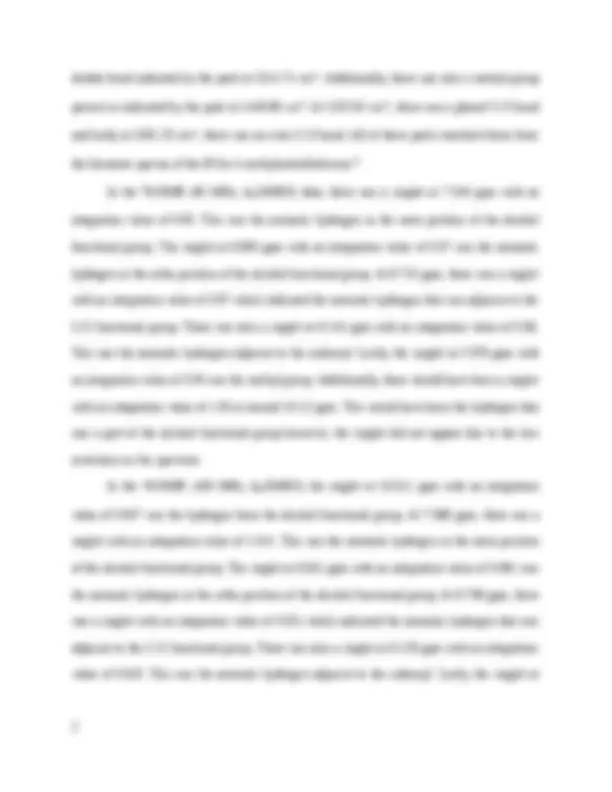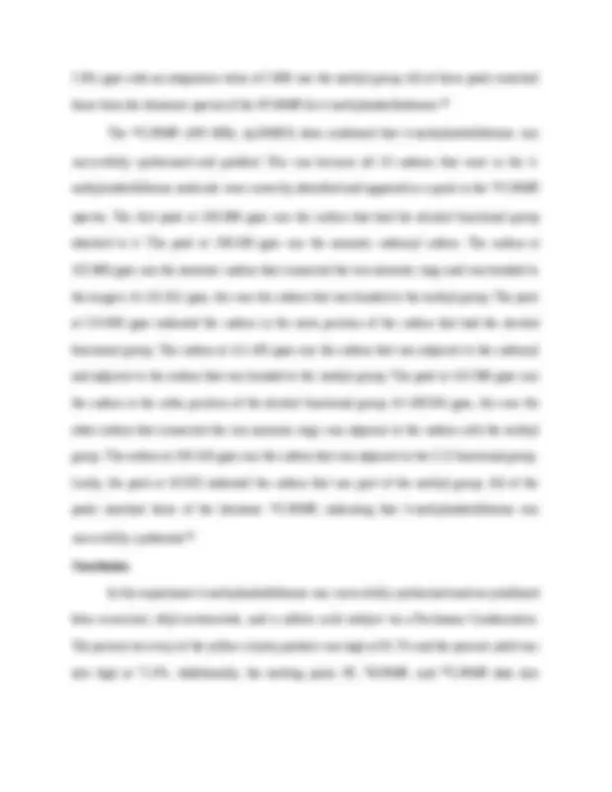






Study with the several resources on Docsity

Earn points by helping other students or get them with a premium plan


Prepare for your exams
Study with the several resources on Docsity

Earn points to download
Earn points by helping other students or get them with a premium plan
Community
Ask the community for help and clear up your study doubts
Discover the best universities in your country according to Docsity users
Free resources
Download our free guides on studying techniques, anxiety management strategies, and thesis advice from Docsity tutors
Report on column chromatography, extraction, distillation
Typology: Exercises
1 / 8

This page cannot be seen from the preview
Don't miss anything!





Introduction Umbelliferones are a part of the coumarin family which occur naturally in plants of the Apiacaea family such as carrots, coriander, and garden angelica all of which have many important biological properties. One property they have is that umbelliferones can normalize prothrombin. In other words, they essentially normalize the clotting and bleeding time in diabetic rats.^1 An example of this in humans is warfarin, one of the most well-known and commonly used coumarin derivatives used in modern medicine, which can be prescribed as a blood thinner in low doses. Additionally, umbelliferones can act as fluorogenic substances that can detect phosphatases and glycosidases. This then converts a fluorescent substrate into a brightly fluorescent umbelliferone. This allows umbelliferones to absorb ultraviolet light and visible light effectively, making it a good sunscreen agent. This property would also make umbelliferones an optical brightener for textiles. 2 Lastly, umbelliferones can also have tumor inhibitory effects in vitro. Therefore, they help defend the digestive tract against oxidative injury and increase the antioxidative capacity in fat bodies.3, In Pechmann Condensations, an acid catalyst is used to make a fused coumarin ring with a phenol and a β-ketoester. 5,6^ The mechanism involves a transesterification/esterification followed by an attack of the activated carbonyl ortho to the oxygen to generate the new ring. However, due to none of the intermediates being stable enough for isolation, the exact order of the three major steps in the Pechmann Condensation is not certain. However, studies have been done and it is widely assumed that the acid catalyzed transesterification reaction occurs first, then the electrophilic aromatic substitution which forms a ring using the newly attached ester group. The reaction is then finalized by a dehydration of the addition product. Pechmann reactions are very useful and are most commonly used to combine activated phenols with ethyl acetoacetate to from 4-methylcoumarins.^7 An example of this occurs in this experiment, as 4-
Experiment 8: Making Umbelliferone via Pechmann Condensation Chem 213W, Spring 2018
methylumbelliferone is made via a Pechmann Condensation reaction. Figure 1 shows the plausible electron pushing mechanism for the synthesis of 4-methylumbelliferone.
Purpose 4-methylumbelliferone was synthesized and recrystallized from resorcinol, ethyl acetoacetate, and a sulfuric acid catalyst via a Pechmann Condensation. The product was refluxed and monitored by TLC until the crude product could be collected. The crude product was then recrystallized with methanol and the purified product was characterized by IR, 1 H- NMR, and 13 C-NMR analysis.
Results and Discussion From resorcinol, ethyl acetoacetate, and a sulfuric acid catalyst, 4-methylumbelliferone was successfully synthesized and recrystallized via a Pechmann Condensation Reaction. The reaction was refluxed, stirred and monitored by TLC to ensure that the reaction reached completion. All the TLC plates taken at 30, 60, and 90 minutes indicated that the reaction lane, which contained the newly synthesized 4-methylumbelliferone, was slightly less polar than 2
double bond indicated by the peak at 1514.74 cm-1^. Additionally, there was also a methyl group
present as indicated by the peak at 1449.89 cm -1. At 1132.64 cm^ -1^ , there was a phenol C-O bond and lastly at 1031.23 cm-1^ , there was an ester C-O bond. All of these peaks matched those from the literature spectra of the IR for 4-methylumbellieferone. 9 In the 1 H-NMR (60 MHz, d (^) 6-DMSO) data, there was a singlet at 7.540 ppm with an integration value of 0.63. This was the aromatic hydrogen in the meta position of the alcohol functional group. The singlet at 6.859 ppm with an integration value of 0.37 was the aromatic hydrogen in the ortho position of the alcohol functional group. At 6.715 ppm, there was a singlet with an integration value of 0.87 which indicated the aromatic hydrogen that was adjacent to the C-O functional group. There was also a singlet at 6.144 ppm with an integration value of 0.58. This was the aromatic hydrogen adjacent to the carbonyl. Lastly, the singlet at 2.378 ppm with an integration value of 3.00 was the methyl group. Additionally, there should have been a singlet with an integration value of 1.00 at around 10-12 ppm. This would have been the hydrogen that was a part of the alcohol functional group however, the singlet did not appear due to the low resolution on the spectrum. In the 1 H-NMR (400 MHz, d6-DMSO) the singlet at 10.511 ppm with an integration value of 0.847 was the hydrogen from the alcohol functional group. At 7.588 ppm, there was a singlet with an integration value of 1.014. This was the aromatic hydrogen in the meta position of the alcohol functional group. The singlet at 6.811 ppm with an integration value of 0.981 was the aromatic hydrogen in the ortho position of the alcohol functional group. At 6.708 ppm, there was a singlet with an integration value of 0.921 which indicated the aromatic hydrogen that was adjacent to the C-O functional group. There was also a singlet at 6.129 ppm with an integration value of 0.915. This was the aromatic hydrogen adjacent to the carbonyl. Lastly, the singlet at
2
2.351 ppm with an integration value of 2.999 was the methyl group. All of these peaks matched those from the literature spectra of the H^1 -NMR for 4-methylumbellieferone.^10 The 13 C-NMR (400 MHz, d6-DMSO) data confirmed that 4-methylumbelliferone was
successfully synthesized and purified. This was because all 10 carbons that were in the 4- methylumbelliferone molecule were correctly identified and appeared as a peak in the 13 C-NMR
spectra. The first peak at 159.398 ppm was the carbon that had the alcohol functional group attached to it. The peak at 158.439 ppm was the aromatic carbonyl carbon. The carbon at 152.883 ppm was the aromatic carbon that connected the two aromatic rings and was bonded to the oxygen. At 151.811 ppm, this was the carbon that was bonded to the methyl group. The peak at 124.909 ppm indicated the carbon in the meta position of the carbon that had the alcohol functional group. The carbon at 111.165 ppm was the carbon that was adjacent to the carbonyl and adjacent to the carbon that was bonded to the methyl group. The peak at 110.288 ppm was the carbon in the ortho position of the alcohol functional group. At 108.534 ppm, this was the other carbon that connected the two aromatic rings was adjacent to the carbon with the methyl group. The carbon at 100.443 ppm was the carbon that was adjacent to the C-O functional group. Lastly, the peak at 16.325 indicated the carbon that was part of the methyl group. All of the peaks matched those of the literature 13 C-NMR, indicating that 4-methylumbelliferone was
successfully synthezied. 11 Conclusion In this experiment 4-methylumbelliferone was successfully synthesized and recrystallized from resorcinol, ethyl acetoacetate, and a sulfuric acid catalyst via a Pechmann Condensation. The percent recovery of the yellow chunky product was high at 91.2% and the percent yield was also high at 71.9%. Additionally, the melting point, IR, 1 H-NMR, and 13 C-NMR data also
References